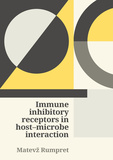Immune inhibitory receptors in host–microbe interaction

Rumpret, Matevz
- Promoter:
- Prof.dr L. (Linde) Meyaard
- Research group:
- Inhibitory receptor lab
- Date:
- March 17, 2022
- Time:
- 12:15 h
Summary
The immune system protects the organism from disease, but inappropriate immune responses can also damage it. Inhibitory receptors can dampen immune responses and prevent tissue damage and inflammatory diseases. In the human genome, genes for over 300 potential immune inhibitory receptors are present. Here, we explore the possible roles inhibitory receptors play in regulating immune responses, in particular the response to bacteria. We suggest two different groups of inhibitory receptors with separate functions and use mathematical models to illustrate their possible modes of operation. We further identify the human S100 family of proteins as the first known ligands for the inhibitory receptor Signal inhibitory receptor on leukocytes-1 (SIRL-1). S100 proteins are released from damaged cells, and we show that SIRL-1 recognises several S100 proteins, suppressing neutrophil ROS production. We suggest that SIRL-1 activation by S100 proteins may help limit tissue damage caused by the immune response. We also show that a group of bacterial peptides, the staphylococcal phenol-soluble modulins, and the structurally and functionally related human peptide cathelicidin LL-37, activate SIRL-1. This suggests that α-helical peptides with an amphipathic arrangement of hydrophobicity may represent a potential molecular pattern recognised by SIRL-1. Furthermore, we argue that also other inhibitory receptors recognise endogenous and microbial patterns. We propose that these inhibitory pattern recognition receptors provide context and help mediate tolerance to microbes and balance responses to danger signals The insights gained here will guide future directions for using SIRL-1 and other inhibitory receptors as therapeutic targets.